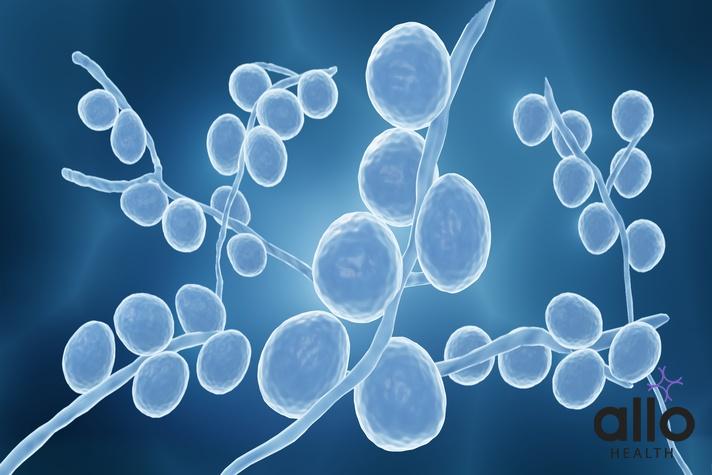Can You Masturbate With A Yeast Infection?

Allo Health is dedicated to personalized well-being, offering support and trusted information tailored to individual health goals. The platform emphasizes human-generated content, led by a distinguished medical team of experts, including physicians and sexual health specialists. Their commitment to credibility involves rigorous fact-checking, authoritative research, and continuous updates to ensure accurate, up-to-date information. Allo Health's unique approach goes beyond conventional platforms, providing expert-led insights and a continuous commitment to excellence, with user feedback playing a crucial role in shaping the platform's authoritative voice.

Dr Saachi has done her MBBS from Kasturba Medical College, Manipal. She has worked as a research observer in Dept. of microbiology; she also has a keen interest in the human psyche, relationships and Sexual health.
Why This Was Upated?
Our experts continually monitor the health and wellness space, and we update our articles when new information became available.
Updated on 06 September, 2023
- Article was updated as part of our commitment to diversity, equity, and inclusion.

"The following blog article provides general information and insights on various topics. However, it is important to note that the information presented is not intended as professional advice in any specific field or area. The content of this blog is for general educational and informational purposes only.
Book consultation
The content should not be interpreted as endorsement, recommendation, or guarantee of any product, service, or information mentioned. Readers are solely responsible for the decisions and actions they take based on the information provided in this blog. It is essential to exercise individual judgment, critical thinking, and personal responsibility when applying or implementing any information or suggestions discussed in the blog."
Sexual health is an important aspect of overall wellbeing, but it can be difficult to navigate when dealing with a condition like a yeast infection. If you are experiencing this common issue, you may be wondering if you can still masturbate. Can You Masturbate With A Yeast Infection?
What Is A Yeast Infection?
A yeast infection, also known as candidiasis, is a common fungal infection caused by an overgrowth of yeast in various parts of the body. The most common yeast responsible for these infections is Candida albicans, but other species of Candida can also be involved. Yeast infections can occur in both men and women and typically affect areas with warm, moist environments.
Here’s a more detailed explanation of yeast infections:
- Causes: Yeast infections are caused by an overgrowth of Candida, which is naturally present in the body, particularly in the mouth, gut, and genital areas. When certain conditions disrupt the balance of microorganisms in these areas, Candida can multiply rapidly, leading to an infection.
- Common Types: Yeast infections can occur in different parts of the body:
- Genital Yeast Infection: Affects the genitals and is more common in women, causing vaginal yeast infections. Men can also get genital yeast infections, typically involving the penis.
- Oral Thrush: Affects the mouth and throat, often seen in infants, the elderly, or individuals with weakened immune systems.
- Cutaneous Candidiasis: Occurs on the skin, causing red, itchy rashes with surrounding scales or pustules.
- Invasive Candidiasis: A severe form of yeast infection that can affect the bloodstream, internal organs, or deeper tissues, mainly in people with compromised immune systems or those undergoing invasive medical procedures.
- Risk Factors: Several factors can increase the risk of developing a yeast infection:
- Weakened Immune System: People with weakened immune systems due to illnesses like HIV/AIDS or those undergoing cancer treatments are more susceptible.
- Antibiotics: These drugs can disrupt the normal balance of bacteria and yeast in the body, potentially leading to an overgrowth of Candida.
- Pregnancy: Hormonal changes during pregnancy can promote yeast growth.
- Diabetes: Poorly controlled diabetes with elevated blood sugar levels can create an environment conducive to yeast overgrowth.
- Uncontrolled HIV Infection: People with uncontrolled HIV are more prone to recurrent yeast infections.
- Sexual Activity: Frequent sexual activity can increase the risk of genital yeast infections in women.
- Symptoms: The symptoms of yeast infections depend on the affected area:
- Genital Yeast Infection: Itching, burning, and redness around the genital area, along with a thick, white, odorless discharge in women.
- Oral Thrush: White patches in the mouth or throat, soreness, difficulty swallowing, and loss of taste.
- Cutaneous Candidiasis: Red, itchy rashes with surrounding scales or pustules.
- Invasive Candidiasis: Symptoms can vary based on the affected organ but may include fever, chills, and organ-specific signs.
- Treatment: Most yeast infections can be treated with antifungal medications, which are available in various forms like creams, suppositories, or oral pills. For severe or recurrent cases, longer treatment courses or different antifungal agents may be necessary. It’s essential to follow the prescribed treatment thoroughly to ensure complete eradication of the infection.
- Prevention: To reduce the risk of yeast infections, some measures include maintaining good hygiene, wearing breathable cotton underwear, choosing a trimmer over a razor for maintaining pubic hair, avoiding douching, and managing underlying health conditions like diabetes.
If you suspect you have a yeast infection, it’s essential to consult a healthcare professional for proper diagnosis and treatment, especially if you have never had one before or if you experience recurrent infections.
Causes & Symptoms Of Yeast Infection
Causes of Yeast Infection
- Imbalance in Microbial Flora: The human body is home to a diverse range of microorganisms, including bacteria and yeast, which normally coexist in harmony. Certain factors can disrupt this balance, allowing yeast (Candida) to overgrow and cause an infection.
- Antibiotics: Antibiotics are designed to kill harmful bacteria, but in doing so, they can also reduce the levels of beneficial bacteria that keep yeast in check. This disruption can lead to an overgrowth of Candida.
- Hormonal Changes: Fluctuations in hormone levels, such as those occurring during pregnancy or the menstrual cycle, can create an environment favorable for yeast growth.
- Weakened Immune System: A compromised immune system due to illnesses like HIV/AIDS, cancer, or immunosuppressive medications can reduce the body’s ability to control yeast overgrowth.
- Uncontrolled Diabetes: Elevated blood sugar levels in people with poorly controlled diabetes provide an ideal environment for yeast to thrive.
- Sexual Transmission: Although uncommon, yeast infections can be transmitted through sexual contact. Male partners of women with vaginal yeast infections may experience genital yeast infections as well. Apart from these, unprotected sexual activity can alter the vaginal pH which might give rise to yeast infections.
- Tight Clothing and Moisture: Wearing tight, non-breathable clothing and spending prolonged periods in moist environments (e.g., sweaty workout clothes, wet bathing suits) can promote yeast growth.
Symptoms of Yeast Infection
- Genital Yeast Infection:
- Itching and irritation in the vaginal or penile area.
- Burning sensation during urination or sexual intercourse.
- Redness and swelling of the genital area.
- Thick, white, odorless vaginal discharge in women (similar discharge may also be seen in men).
- Oral Thrush:
- White or cream-colored patches on the tongue, inner cheeks, roof of the mouth, or throat.
- Soreness and discomfort in the mouth.
- Difficulty swallowing or a feeling of food getting stuck in the throat.
- Loss of taste.
- Cutaneous Candidiasis:
- Red, itchy rash with defined edges and surrounding scales or pustules.
- The rash may appear in skin folds, such as the armpits, groin, or under the breasts.
- Invasive Candidiasis:
- Symptoms can vary depending on the affected organ or system.
- In the bloodstream: Fever, chills, rapid heartbeat, low blood pressure, and sepsis (severe cases).
- In the urinary tract: Pain or discomfort during urination, frequent urination, and possibly blood in urine.
- In the digestive system: Abdominal pain, diarrhea, nausea, and vomiting.
Can You Masturbate With A Yeast Infection?
When dealing with a yeast infection, it’s essential to understand that the infection is caused by an overgrowth of yeast (usually Candida) in a particular area, such as the genitals. It’s a common misconception that masturbation itself can cause or worsen yeast infections. In reality, the act of masturbation does not directly cause yeast infections.
There are some considerations to keep in mind regarding masturbation and yeast infections:
- Hygiene: During a yeast infection, the affected area can be sensitive, and excessive rubbing or irritation can exacerbate the symptoms. Practicing good hygiene is crucial, and touching the infected area with unwashed hands or using dirty sex toys can introduce bacteria and potentially worsen the infection. Washing your hands and cleaning sex toys before and after use can help reduce the risk of further irritation.
- Avoid Aggravating Factors: As mentioned earlier, tight clothing, non-breathable fabrics, and prolonged moisture can create an environment that encourages yeast overgrowth. While masturbation itself isn’t the cause, certain conditions associated with it, like sweating in tight clothing afterward, could potentially worsen the infection.
- Pain or Discomfort: Some individuals with yeast infections may experience discomfort or pain in the genital area, which can affect their desire or ability to masturbate. If you’re experiencing significant discomfort, it’s best to avoid activities that may worsen it until the infection is treated.
- Potential for Spread: While masturbation itself doesn’t spread yeast infections, sexual activity with a partner can transmit the infection between partners. It’s crucial to communicate openly with sexual partners about any existing infections to avoid transmission and practice safe sex.
Treatment and Timing
If you have a yeast infection, it’s essential to focus on proper treatment. Antifungal medications, available in various forms such as creams, suppositories, or oral pills, are commonly prescribed to treat yeast infections. It’s crucial to complete the full course of treatment as prescribed by your healthcare provider, even if symptoms improve, to ensure the infection is fully eradicated.
As a general guideline, if you have a yeast infection and experience discomfort during masturbation, it’s best to avoid it until the infection is completely resolved. Once the infection has cleared, you can resume normal activities, including masturbation, with appropriate hygiene practices.
Remember, yeast infections are common and treatable, and if you’re unsure about the best course of action or your symptoms persist or worsen, consult a healthcare professional for proper guidance and treatment.
Can Masturbation Worsen a Yeast Infection?
Masturbation itself does not directly cause yeast infections. Certain factors related to masturbation can potentially worsen a yeast infection or increase discomfort during an existing infection. It’s essential to understand these factors to take appropriate precautions:
- Irritation: During masturbation, friction and rubbing can cause irritation in the genital area. If you already have a yeast infection, this irritation can exacerbate the symptoms, such as itching, burning, and redness.
- Unhygienic Practices: Touching the infected genital area with unwashed hands or using dirty sex toys can introduce bacteria and potentially worsen the infection. Maintaining good hygiene is crucial to avoid further complications.
- Moisture: Prolonged moisture in the genital area, such as sweating during or after masturbation, can create an environment conducive to yeast overgrowth. Yeast thrives in warm, moist environments, so avoiding excess moisture is important.
- Secondary Infections: Masturbation or sexual activity with a partner can potentially introduce other bacteria or infections into the genital area, leading to secondary infections in addition to the yeast infection.
- Discomfort: If you are experiencing discomfort or pain in the genital area due to the yeast infection, masturbation may not be pleasurable or may worsen the discomfort.
Precautions and Considerations
If you have a yeast infection and want to masturbate, there are some precautions you can take to reduce the risk of worsening the infection:
- Hygiene: Wash your hands before and after masturbation to minimize the risk of introducing additional bacteria to the infected area.
- Lubrication: If you decide to masturbate, consider using a water-based lubricant to reduce friction and minimize irritation.
- Breathable Clothing: Wear loose, breathable underwear and clothing to allow proper airflow and reduce moisture in the genital area.
- Avoid Aggravating Factors: If you experience discomfort during masturbation due to the yeast infection, it’s best to refrain from it until the infection is fully treated and symptoms have subsided.
- Consult a Healthcare Provider: If you are unsure about whether it’s safe to masturbate with an existing yeast infection or if your symptoms persist or worsen, consult a healthcare provider for personalized advice and treatment.
When to Seek Medical Attention for a Yeast Infection
While yeast infections are generally common and treatable, there are certain situations when seeking medical attention is crucial. Here are the circumstances in detail when you should consult a healthcare provider:
- First-Time Infection: If you’ve never had a yeast infection before and are experiencing symptoms such as itching, burning, and abnormal discharge, it’s essential to seek medical attention. A healthcare provider can properly diagnose the infection and confirm that it is indeed a yeast infection. Other conditions, such as bacterial vaginosis or trichomonas vaginalis, may have similar symptoms but require different treatments.
- Recurrent Infections: If you have had multiple yeast infections in the past, and they keep coming back despite self-treatment, consult a healthcare provider. Recurrent yeast infections may be a sign of an underlying issue that needs to be addressed, such as uncontrolled diabetes or a weakened immune system.
- Severe Symptoms: If your symptoms are particularly severe, causing significant discomfort, pain, or interfering with your daily activities, seeking medical attention can help provide relief and appropriate treatment options.
- Pregnancy: Pregnant women who suspect a yeast infection should always consult their healthcare provider before using any over-the-counter medications or home remedies. The safety and efficacy of certain treatments during pregnancy need to be considered.
- Uncertain Diagnosis: If you are unsure whether your symptoms are due to a yeast infection or another condition, it’s best to get a proper diagnosis from a healthcare professional. Self-diagnosis can lead to inappropriate treatment and delay in resolving the actual issue.
- Complications: If you suspect the yeast infection has led to complications, such as the infection spreading to other areas or causing urinary concerns, it’s essential to seek medical attention promptly.
- Presence of Other Health Conditions: If you have underlying health conditions, such as diabetes, a weakened immune system, or a history of sexually transmitted infections, seeking medical attention is crucial. These conditions can impact the severity and treatment of the yeast infection.
- Unusual Discharge: If you notice any unusual changes in vaginal discharge, such as a foul smell, green or yellow color, or blood-tinged discharge, it could indicate a different infection or complication that requires medical evaluation.
- Home Remedies Not Effective: If you’ve tried over-the-counter antifungal treatments or home remedies for a reasonable period and haven’t seen improvement in your symptoms, it’s time to consult a healthcare provider.
Treating Yeast Infections
Treating yeast infections typically involves antifungal medications to eliminate the overgrowth of yeast (usually Candida) that is causing the infection. The treatment approach may vary depending on the location and severity of the infection. Here’s a detailed overview of the treatment options:
Over-the-Counter (OTC) Medications
For mild to moderate yeast infections, you can find antifungal creams, ointments, or suppositories available without a prescription at most pharmacies. Common active ingredients in OTC medications include:
- Clotrimazole
- Miconazole
- Tioconazole
- Butoconazole
Usage: Follow the instructions provided with the product. Typically, you’ll apply the cream and/or insert the suppository into the affected area (vagina or penis) for several days, as recommended on the packaging. Complete the full course of treatment, even if symptoms improve, to ensure complete eradication of the infection.
Prescription-Strength Medications
For more severe or recurrent yeast infections, your healthcare provider may prescribe stronger antifungal medications in the form of:
- Oral Tablets: Azole medications like fluconazole or itraconazole are commonly prescribed in a single-dose or multiple-dose regimen.
- Topical Creams or Suppositories: Prescription-strength versions of clotrimazole, miconazole, or other antifungal agents may be recommended for more stubborn infections.
Usage: Follow your healthcare provider’s instructions carefully. Oral tablets are usually taken as a single dose, while topical creams or suppositories are used for a specified duration, which may be longer than OTC treatments.
Creams with Corticosteroids
In some cases, your healthcare provider may prescribe a combination of antifungal cream with a low-dose corticosteroid to help reduce inflammation and itching.
Avoiding Potential Irritants
During treatment, it’s essential to avoid potential irritants that can worsen symptoms or disrupt the healing process. These may include scented hygiene products, douching, and wearing tight, non-breathable underwear or clothing.
Treating Underlying Conditions
If there are underlying health concerns, such as uncontrolled diabetes or a weakened immune system, addressing these conditions is vital to reduce the risk of recurrent infections.
Partner Treatment
If you have a genital yeast infection, it’s essential for sexual partners to be treated simultaneously to prevent reinfection.
Probiotics
There is some evidence to suggest that probiotics containing Lactobacillus species may help restore the balance of the vaginal microbiota and reduce the risk of recurrent vaginal yeast infections. More research is needed to fully understand their effectiveness.
Important Considerations
- If you are pregnant, consult your healthcare provider before using any medications or home remedies for a yeast infection.
- If you experience severe or recurrent yeast infections, it’s crucial to consult a healthcare provider to identify any underlying health conditions that may be contributing to the infections.
- Avoid sexual activity during treatment or use condoms to prevent the spread of the infection to your partner.
- If your symptoms do not improve with treatment or worsen, contact your healthcare provider for reevaluation.
It’s essential to complete the full course of treatment as prescribed by your healthcare provider to ensure the infection is fully eradicated. If you have any concerns or questions about your yeast infection treatment, don’t hesitate to consult a healthcare professional for personalized guidance.
Frequently Asked Questions
(1) Can masturbation cause a yeast infection?
Masturbation itself does not cause yeast infections. Yeast infections are typically caused by an overgrowth of the fungus Candida in the vagina. Activities that disrupt the natural balance of the vaginal flora, such as using irritating substances or not maintaining proper hygiene, could potentially contribute to the development of a yeast infection.
(2) What are the risks of masturbating with a yeast infection?
Masturbating with a yeast infection may lead to increased discomfort and irritation in the genital area. The friction and contact could aggravate the inflamed tissues and worsen the symptoms. Additionally, there’s a slight risk of spreading the infection if proper hand hygiene is not observed.
(3) How can I alleviate discomfort during masturbation with a yeast infection?
To minimize discomfort, try using a water-based lubricant during masturbation. Avoid any products that contain potentially irritating chemicals or additives. Additionally, opt for gentle and slow movements to reduce friction and irritation. If you experience persistent discomfort, it may be best to avoid masturbation until the yeast infection clears up.
(4) Can masturbation affect yeast infection treatment?
Masturbation itself is unlikely to affect the effectiveness of yeast infection treatment. It’s essential to follow your healthcare provider’s advice and complete the prescribed treatment regimen. Avoid using any topical treatments immediately before or after masturbation to ensure the medication has enough time to work and does not get washed away.
(5) Should I avoid using sex toys during a yeast infection?
It is advisable to avoid using sex toys during a yeast infection. These toys can harbor yeast and bacteria, potentially worsening the infection or leading to reinfection. If you choose to use sex toys, ensure they are thoroughly cleaned and sanitized before and after each use.
(6) Can masturbation help clear a yeast infection?
Masturbation itself is not a treatment for yeast infections. While sexual activity, including masturbation, can increase blood flow to the genital area, there is no scientific evidence to suggest that it can cure a yeast infection. It’s essential to use appropriate antifungal treatments as prescribed by a healthcare professional.
(7) Is it safe to have sex during a yeast infection?
Engaging in sexual intercourse during a yeast infection may cause discomfort for both partners and could potentially spread the infection. It’s best to abstain from sex until the infection has completely cleared up to avoid any complications or transmission.
(8) Can men masturbate if their partner has a yeast infection?
Yes, men can masturbate if their partner has a yeast infection. They should be cautious about maintaining good hand hygiene before and after masturbation to reduce the risk of spreading the infection between partners. Avoid sexual contact if any symptoms or signs of infection are present in either partner.
(9) Are there any natural remedies for yeast infections that won’t interfere with masturbation?
Some individuals may explore natural remedies for yeast infections, such as probiotics, boric acid suppositories, or tea tree oil. It’s crucial to consult a healthcare professional before trying any natural remedies, especially if you plan to continue masturbating. Natural remedies may not be suitable for everyone and could potentially interact with certain treatments or cause further irritation.






































